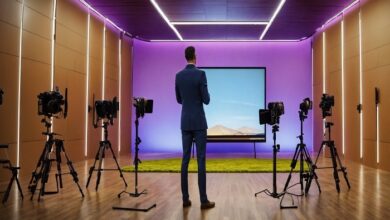VR: A Revolutionary Technology for Immersive Experiences

VR, or virtual reality, is a technology that creates a simulated environment that can be experienced through a headset or a screen. VR can transport you to different places, times, and realities, and make you feel like you are actually there. VR can be used for various purposes, such as entertainment, education, training, therapy, and more. In this blog post, we will explore the history, features, benefits, and challenges of VR, as well as some of the best VR games and apps that you can try.
History of VR
The concept of VR can be traced back to the 19th century, when inventors and artists experimented with devices and techniques to create immersive illusions. Some of the early examples of VR are the stereoscope, which was a device that used two images to create a 3D effect; the panorama, which was a painting or a photograph that covered a large area and created a sense of depth; and the kinetoscope, which was a device that showed short films through a peephole.
The term “virtual reality” was coined by Jaron Lanier in the 1980s, when he founded VPL Research, one of the first companies to develop and sell VR products. Some of the products that VPL Research created were the EyePhone, which was a head-mounted display that tracked the user’s head movements; the DataGlove, which was a glove that tracked the user’s hand movements; and the DataSuit, which was a suit that tracked the user’s body movements.
The 1990s saw the rise and fall of VR as a mainstream technology. Several companies tried to market VR products to consumers, such as Sega, Nintendo, Atari, and Virtuality. However, most of these products failed to deliver on their promises of high-quality and realistic VR experiences. They were also expensive, bulky, uncomfortable, and prone to cause motion sickness and eye strain.
The 2000s witnessed the resurgence of VR as a research and development field. Several advances in technology, such as faster processors, cheaper sensors, better graphics, and wireless connectivity, enabled the creation of more sophisticated and affordable VR devices. Some of the notable examples of VR devices in this period are the Google Cardboard, which was a low-cost headset that used a smartphone as a screen; the Oculus Rift, which was a high-end headset that offered a wide field of view and low latency; and the HTC Vive, which was a headset that used external sensors to track the user’s position and movement in a room-scale space.
The 2010s marked the emergence of VR as a popular and accessible technology. Several companies launched their own VR products and platforms, such as Sony PlayStation VR, Samsung Gear VR, Microsoft HoloLens, Facebook Oculus Quest, and Google Daydream. These products and platforms offered various features and options for different types of users and applications. They also integrated with other technologies, such as augmented reality (AR), which is a technology that overlays digital information on top of the real world; mixed reality (MR), which is a technology that combines elements of both VR and AR; and artificial intelligence (AI), which is a technology that enables machines to perform tasks that require human intelligence.
Features of VR
VR has several features that distinguish it from other forms of media and entertainment. Some of these features are:
- Immersion: Immersion is the degree to which VR makes you feel like you are present in the virtual environment. Immersion depends on various factors, such as the quality of the graphics, sound, haptics (touch), smell, taste, etc.; the level of interaction with the virtual environment and objects; and the consistency and coherence of the virtual environment with your expectations and reality.
- Interactivity: Interactivity is the degree to which VR allows you to manipulate and influence the virtual environment and objects. Interactivity depends on various factors, such as the type and number of input devices (controllers, gloves, wands, etc.); the type and number of output devices (headsets, screens, speakers, etc.); and the responsiveness and feedback of the virtual environment and objects.
- Narrative: Narrative is the degree to which VR tells a story or conveys a message through the virtual environment and objects. Narrative depends on various factors, such as the genre and theme of the VR experience; the plot and characters of the VR experience; the choices and consequences of your actions in the VR experience; and the emotional impact of the VR experience.
- Sociality: Sociality is the degree to which VR enables you to communicate and collaborate with other users in the virtual environment. Sociality depends on various factors, such as the number and identity of other users in the virtual environment; the mode and quality of communication and collaboration with other users (voice, text, gesture, etc.); and the sense of community and belonging with other users.
Benefits of VR
VR has many benefits and advantages for various purposes and applications, such as:
- Entertainment: VR can provide a fun and exciting way to enjoy games, movies, music, sports, and other forms of entertainment. VR can also create new and unique forms of entertainment, such as virtual concerts, theme parks, museums, etc.
- Education: VR can enhance learning and teaching by providing immersive and interactive experiences that can stimulate curiosity, creativity, and engagement. VR can also enable access to information and resources that may be otherwise difficult or impossible to obtain, such as historical events, distant places, scientific phenomena, etc.
- Training: VR can improve skills and performance by providing realistic and safe simulations that can replicate various scenarios and situations. VR can also provide feedback and assessment that can help identify strengths and weaknesses, and provide guidance and support.
- Therapy: VR can help treat various physical and mental health conditions by providing exposure therapy, cognitive behavioral therapy, relaxation therapy, pain management, etc. VR can also help improve well-being and quality of life by providing positive and enjoyable experiences that can reduce stress, anxiety, depression, etc.
Challenges of VR
VR also has some challenges and limitations that need to be addressed and overcome, such as:
- Cost: VR devices and content can be expensive and inaccessible for many people. The cost of VR depends on various factors, such as the quality and features of the devices and content; the availability and compatibility of the devices and content; and the maintenance and update of the devices and content.
- Comfort: VR devices and content can cause discomfort and health issues for some people. The comfort of VR depends on various factors, such as the weight and fit of the devices; the duration and intensity of the use; the motion sickness and eye strain caused by the devices; and the psychological effects of the content.
- Content: VR devices and content can be limited and unsatisfactory for some people. The content of VR depends on various factors, such as the quantity and diversity of the content; the quality and realism of the content; the interactivity and narrative of the content; and the sociality and ethics of the content.
Best VR Games and Apps
VR has a wide range of games and apps that cater to different tastes and preferences. Some of the best VR games and apps that you can try are:
- Beat Saber: Beat Saber is a rhythm game that lets you slash blocks with lightsabers in sync with music. It is a fun and addictive game that tests your reflexes, coordination, and musicality.
- Half-Life: Alyx: Half-Life: Alyx is a first-person shooter game that is set in the Half-Life universe. It is a thrilling and immersive game that features realistic physics, combat, puzzles, exploration, etc.
- Superhot VR: Superhot VR is an action game that lets you manipulate time with your movements. It is a challenging and exhilarating game that requires you to dodge bullets, fight enemies, and use weapons in slow motion.
- Google Earth VR: Google Earth VR is an app that lets you explore the world in 3D. It is an amazing and educational app that allows you to visit famous landmarks, natural wonders, and personal places in virtual reality.
- The Climb 2: The Climb 2 is a sports game that lets you climb mountains in different locations. It is an adventurous and realistic game that simulates climbing techniques, challenges, and views in virtual reality.
Conclusion
VR is a revolutionary technology that creates a simulated environment that can be experienced through a headset or a screen. VR can transport you to different places, times, and realities, and make you feel like you are actually there. VR has several features that distinguish it from other forms of media and entertainment, such as immersion, interactivity, narrative, and sociality. VR has many benefits and advantages for various purposes and applications, such as entertainment, education, training, and therapy. VR also has some challenges and limitations that need to be addressed and overcome, such as cost, comfort, and content. VR has a wide range of games and apps that cater to different tastes and preferences. Some of the best VR games and apps that you can try are Beat Saber, Half-Life: Alyx, Superhot VR, Google Earth VR, and The Climb 2.
Read more about: cloudsports24



